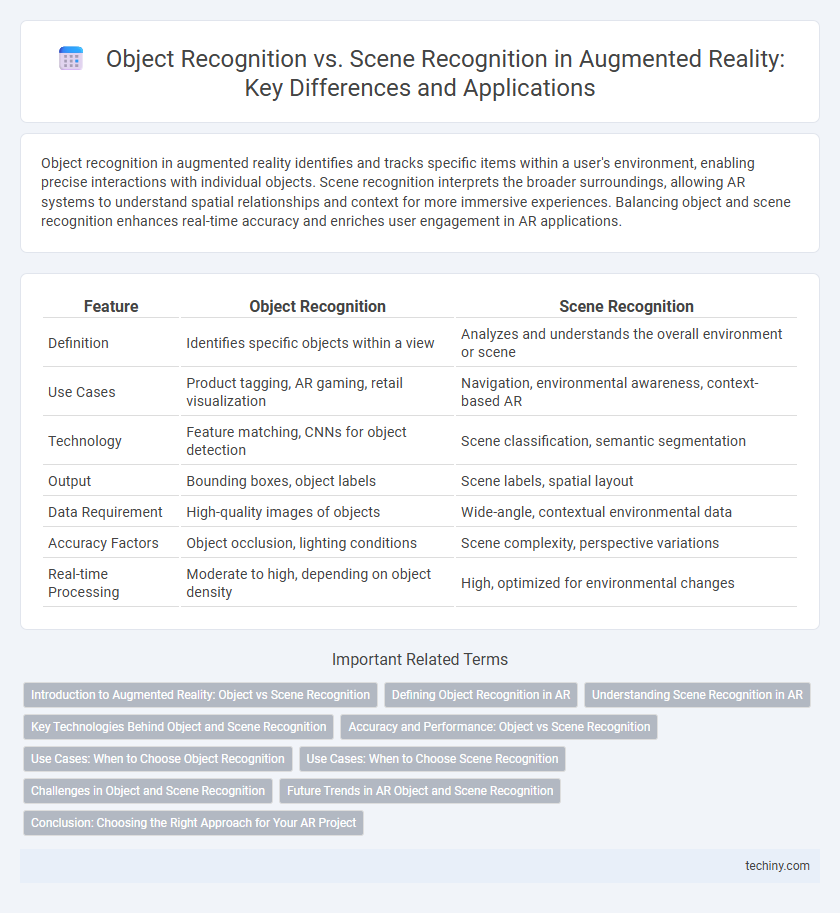Object recognition in augmented reality identifies and tracks specific items within a user's environment, enabling precise interactions with individual objects. Scene recognition interprets the broader surroundings, allowing AR systems to understand spatial relationships and context for more immersive experiences. Balancing object and scene recognition enhances real-time accuracy and enriches user engagement in AR applications.
Table of Comparison
| Feature | Object Recognition | Scene Recognition |
|---|---|---|
| Definition | Identifies specific objects within a view | Analyzes and understands the overall environment or scene |
| Use Cases | Product tagging, AR gaming, retail visualization | Navigation, environmental awareness, context-based AR |
| Technology | Feature matching, CNNs for object detection | Scene classification, semantic segmentation |
| Output | Bounding boxes, object labels | Scene labels, spatial layout |
| Data Requirement | High-quality images of objects | Wide-angle, contextual environmental data |
| Accuracy Factors | Object occlusion, lighting conditions | Scene complexity, perspective variations |
| Real-time Processing | Moderate to high, depending on object density | High, optimized for environmental changes |
Introduction to Augmented Reality: Object vs Scene Recognition
Object recognition in augmented reality involves identifying and tracking specific items or markers within a user's environment, enabling interactive experiences tethered to tangible objects. Scene recognition processes the entire environment to understand spatial layout and context, facilitating more immersive and dynamic AR applications. Both technologies leverage computer vision algorithms and machine learning to interpret real-world inputs, with object recognition focusing on discrete elements and scene recognition analyzing broader environmental structures.
Defining Object Recognition in AR
Object recognition in augmented reality (AR) enables devices to identify and track specific objects within a user's environment by analyzing visual data through machine learning algorithms. This technology allows AR applications to overlay digital information accurately onto physical objects, enhancing user interaction and experience. Unlike scene recognition, which interprets broader environments, object recognition focuses on pinpointing individual items for precise augmentation.
Understanding Scene Recognition in AR
Scene recognition in augmented reality enables the system to identify and interpret complex environments by analyzing spatial relationships, textures, and lighting conditions. Unlike object recognition, which isolates single items, scene recognition processes entire surroundings to enhance user interaction and context awareness. This capability allows AR applications to deliver more immersive experiences by adapting digital content based on the detected scene features.
Key Technologies Behind Object and Scene Recognition
Object recognition in augmented reality relies heavily on convolutional neural networks (CNNs) and feature extraction algorithms like SIFT and SURF to identify and categorize individual items based on distinct visual characteristics. Scene recognition integrates semantic segmentation and simultaneous localization and mapping (SLAM) technologies to interpret and reconstruct entire environments, enhancing spatial awareness and interaction. Advances in deep learning architectures and sensor fusion techniques continue to improve the accuracy and real-time performance of both object and scene recognition systems in AR applications.
Accuracy and Performance: Object vs Scene Recognition
Object recognition in augmented reality typically offers higher accuracy by identifying specific items with detailed features, while scene recognition excels at interpreting broader environmental contexts though it may sacrifice precision. Performance-wise, object recognition demands more computational power due to fine-grained analysis, whereas scene recognition benefits from faster processing by leveraging overall spatial layouts. Balancing accuracy and speed is crucial in AR applications to optimize user experience depending on whether precise object interaction or real-time environmental understanding is prioritized.
Use Cases: When to Choose Object Recognition
Object recognition excels in AR applications requiring precise identification and tracking of individual items, such as retail product visualization, maintenance support for machinery, and interactive educational tools focused on single objects. This technology enables detailed interaction with specific objects, enhancing user engagement and accuracy in environments like warehouses, museums, and assembly lines. Choosing object recognition is ideal when the AR experience demands exact object identification rather than understanding the broader environment or scene context.
Use Cases: When to Choose Scene Recognition
Scene recognition is ideal for applications requiring holistic environmental understanding, such as indoor navigation, virtual tours, or augmented reality gaming where spatial context is crucial. Unlike object recognition, which identifies specific items, scene recognition processes the overall setting to enable seamless interaction within complex spaces. This approach enhances user experience in scenarios needing accurate mapping and contextual awareness, particularly in dynamic or large-scale environments.
Challenges in Object and Scene Recognition
Object recognition in augmented reality faces challenges such as occlusion, varying lighting conditions, and real-time processing requirements that demand robust feature extraction algorithms. Scene recognition encounters difficulties in interpreting complex environments with dynamic elements, inconsistent textures, and diverse spatial layouts that complicate accurate context understanding. Both tasks require advanced machine learning models capable of adapting to diverse scenarios while maintaining high accuracy and low latency for seamless AR experiences.
Future Trends in AR Object and Scene Recognition
Future trends in augmented reality emphasize advancements in AI-driven object recognition and scene recognition, aiming to enhance real-time accuracy and contextual understanding. Integration of multimodal sensors and neural network optimization will enable seamless interaction with complex environments, while increased computational power supports dynamic object updating and immersive scene interpretation. Emerging technologies such as 5G connectivity and edge computing will further reduce latency, allowing instantaneous AR experiences critical for gaming, retail, and industrial applications.
Conclusion: Choosing the Right Approach for Your AR Project
Object recognition excels in identifying specific items within a scene, making it ideal for AR applications requiring precise interaction with individual objects, such as retail or industrial maintenance. Scene recognition provides broader environmental understanding, enhancing AR experiences that depend on spatial context and navigation, commonly used in gaming or architectural visualization. Selecting the right approach depends on the project's goals, where object recognition suits detailed tasks and scene recognition supports immersive, context-aware applications.
Object Recognition vs Scene Recognition Infographic

 techiny.com
techiny.com